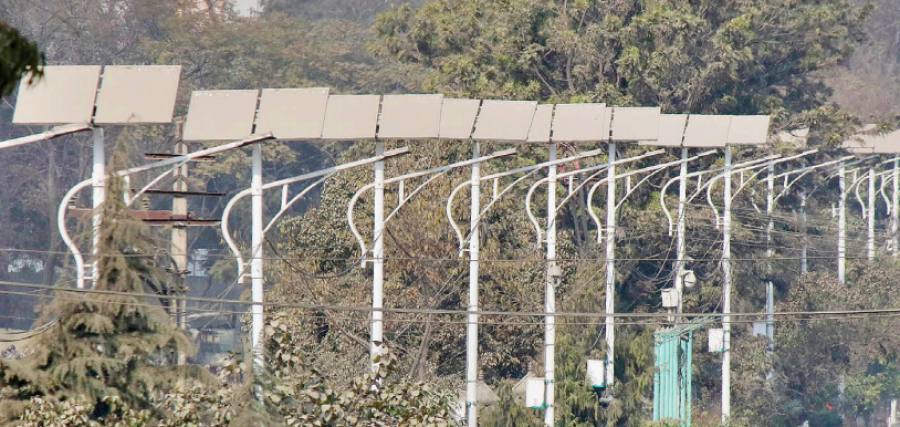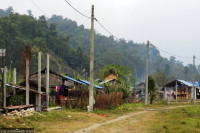National
Lalitpur to install 669 smart electric street lamps on three routes
It is a first in the country but could be expanded in other parts of the country depending on interest, says Kul Man Ghising of NEA
Anup Ojha
Learning a lesson from its own inability to maintain solar street lamps, Lalitpur Metropolitan City has started an initiative of installing smart electrically-powered street lamps on three different routes with the technical support of Nepal Electricity Authority.
The city Tuesday announced it would install 669 lamps within two months at a cost of Rs 52 million.
“These lamps will run under a centralised control system and this is the first step we have taken to make Lalitpur a smart city,” said Chiri Babu Maharjan, the city mayor.
The new street lamps are based on radio controlled signals, where a central power control module would control the lights via the internet. If a certain lamp is not working, the central control would be able to sense it so that the problem can be addressed.
“The new street lamps can be made dim when there is no need for light,”said Kulman Ghising, managing director of Nepal Electricity Authority. “This is of its kind system in Nepal,” said Ghising.
He said the current model of solar lamps were not durable as they have a lifespan of only five years, after which their batteries need recharging.
The city has announced to pay the electricity bill to the authority annually.
“With the new electric lights we will be able to control the consumption of electricity, as they could be made dim after midnight when there is less human mobility,” said Maharjan.
In 2016, the city had installed 940 solar lamps at a total cost of Rs 90 million, of which Rs 60 million was invested by the central government.
The contractors have been given 45 days to install the new lamps.
“Over 80 percent of the solar lamps in Lalitpur are of no use now,” said Maharjan.
According to Sagar Gnawali, assistant manager at the NEA, one street lamp can be installed for about Rs 30,000 to Rs 40,000, while the cost of installing a solar lamp is at least Rs 130,000.
Lalitpur plans to install 50, 80 and 120 (watts) poles depending upon the human mobility in the area on three routes— Kupondole to Satdobato; Bakhundol to Patan Dhoka; and Pulchowk to Gwarko via Mangalbazar.
Meanwhile, the solar-powered street lamps in Kathmandu are also more or less defunct.
Kathmandu Metropolitan City had installed 1,285 solar street lamps under a public-private partnership model, in which the private company, BK Traders and Supply, had invested Rs 227 million in 2016.
It was a 10-year deal with the private company as per which the traders could use the electricity poles for advertising but had to maintain the lights. Four years since the deal, and many of these solar lamps do not work due to a lack of regular maintenance.
Earlier, the Kathmandu city authority had installed 1,600 solar lamps as part of Kathmandu Ujyalo Programme in 2014 with support from the Asian Development Bank. Over the years, many of these lamps have fallen into disrepair.
After the failure of solar lamps,the city last year had allocated Rs 50 million to install 6,000 electric street lamps at various road sections.
Electricity bills for these street lights remain unpaid.
“The municipalities in Kathmandu Valley have accrued a hefty amount of unpaid electricity bill due to a lack of proper billing system. NEA does not know how much the arrears is. But with this new system, computers will show the amount of electricity consumed,” said Gawali of the NEA.
Ghising further said the NEA is working to install the centralised control street lamps in all local units, as they are cost effective and more efficient. He said Bharatpur Metropolitan City is planning to install such lights in the future.
“But Kathmandu Metropolitan City has so far shown no interest,” said Ghising.
When the Post contacted the Department of Roads to inquire the present status of the street lamp it didn’t have exact data. “All the street lamps in the Valley are installed by the local governments, but none of them are properly functioning,” said Shiva Hari Sapkota, spokesperson at the department.
“Those solar lamps were installed when the country was reeling under loadshedding. The situation is different now, electric lamps are way better than solar lamps,” said Sapkota.




 8.12°C Kathmandu
8.12°C Kathmandu.jpg)













%20(1).jpg&w=300&height=200)

